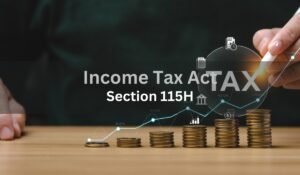Section 112A(2) of the Income Tax Act governs the calculation of tax payable on long-term capital gains (LTCG) arising from the transfer of certain equity-related investments. This provision specifically outlines the method for calculating the tax liability when an assessee’s total income includes LTCG from equity shares, units of equity-oriented mutual funds, or units of business trusts, and it clarifies the aggregate tax payable.
In this article, we will focus on the details of Section 112A(2), explaining how the tax is calculated on LTCG exceeding ₹1,00,000, the exemptions provided, and the special provisions for individuals and Hindu Undivided Families (HUFs).
What is Section 112A(2)?
Section 112A(2) comes into play when the total income of an assessee includes long-term capital gains from specified equity-related investments where Securities Transaction Tax (STT) has been paid. This sub-section explains how the tax payable is computed by dividing it into two components:
- Tax on LTCG exceeding ₹1,00,000 at a rate of 10%.
- Tax on the total income excluding such LTCG as per the applicable slab rates.

Tax Calculation Under Section 112A(2)
According to Section 112A(2), the tax payable by the assessee on their total income (which includes LTCG) is the aggregate of two components:
- The amount of income tax calculated on the LTCG exceeding ₹1,00,000 at the rate of 10%.
- The amount of income tax on the total income as reduced by the LTCG, calculated as if this reduced income were the total income of the assessee.
Example:
Suppose an individual has the following:
- LTCG from equity shares = ₹2,00,000.
- Other income = ₹5,00,000.
Here’s how the tax will be computed under Section 112A(2):
- Tax on LTCG exceeding ₹1,00,000:
- LTCG exceeding ₹1,00,000 = ₹2,00,000 – ₹1,00,000 = ₹1,00,000.
- Tax on ₹1,00,000 @ 10% = ₹10,000.
- Tax on Other Income:
- Total income excluding LTCG = ₹5,00,000.
- Assuming the individual is below 60 years, the applicable tax on ₹5,00,000 would be ₹12,500 (as per the slab rates).
Thus, the total tax payable will be ₹10,000 (on LTCG) + ₹12,500 (on other income) = ₹22,500.
Exemption for Individuals and HUFs Under Section 112A(2)
Section 112A(2) includes a special provision for individuals and Hindu Undivided Families (HUFs) who are residents in India. It provides relief when their total income, excluding LTCG, is below the basic exemption limit. In such cases, the LTCG is reduced by the amount by which the total income falls short of the exemption limit.
How It Works:
For individual residents and HUFs, if the total income (excluding LTCG) is below the basic exemption limit (₹2,50,000 for individuals below 60 years, ₹3,00,000 for individuals aged 60-80 years, and ₹5,00,000 for individuals above 80 years), the long-term capital gains for tax purposes will be reduced by the amount of shortfall.
Example:
Let’s assume an individual taxpayer has:
- LTCG = ₹2,50,000.
- Other income = ₹1,50,000.
Since the basic exemption limit for an individual below 60 years of age is ₹2,50,000, the shortfall in total income (₹2,50,000 – ₹1,50,000 = ₹1,00,000) can be used to reduce the taxable LTCG. Therefore, the taxable LTCG will be ₹2,50,000 – ₹1,00,000 = ₹1,50,000.
Now, since the taxable LTCG exceeds ₹1,00,000, the tax will be computed as:
- Tax on ₹50,000 (LTCG exceeding ₹1,00,000) @ 10% = ₹5,000.
Thus, the total tax payable will be ₹5,000 on LTCG, and no tax on other income as it falls below the exemption limit.
Important Points to Consider
- Applicability of STT: The benefits of Section 112A(2) only apply if the equity shares or mutual fund units were subject to Securities Transaction Tax (STT) at the time of acquisition or transfer. Transactions without STT may be excluded from the provisions of this section.
- Basic Exemption Limit: For individual taxpayers and HUFs, the basic exemption limit plays a crucial role in reducing taxable LTCG. For others like companies and firms, this provision does not apply, and they are liable for LTCG tax on gains exceeding ₹1,00,000 without any reductions.
- No Indexation Benefit: Taxpayers should note that indexation benefits (used to adjust the purchase price of an asset for inflation) are not available for LTCG under Section 112A. Gains are taxed at 10% flat after the ₹1,00,000 exemption.
Frequently Asked Questions (FAQs)
1. What is the tax rate on long-term capital gains under Section 112A(2)? Long-term capital gains exceeding ₹1,00,000 are taxed at 10% under Section 112A(2) without indexation benefits.
2. Is there any tax exemption for LTCG under Section 112A(2)? Yes, there is a tax exemption for LTCG up to ₹1,00,000. Gains above this threshold are taxed at 10%.
3. Can I reduce my taxable LTCG if my total income is below the basic exemption limit? Yes, if you are an individual or HUF resident and your total income (excluding LTCG) falls below the basic exemption limit, you can reduce your taxable LTCG by the shortfall.
4. Does Section 112A(2) apply to all types of capital gains? No, Section 112A(2) applies only to long-term capital gains arising from the transfer of listed equity shares, units of equity-oriented mutual funds, and units of business trusts where STT has been paid.
Conclusion
Section 112A(2) provides clarity on the taxation of long-term capital gains from equity investments, ensuring that investors with gains exceeding ₹1,00,000 are taxed at a reasonable rate of 10%. The section also offers relief to low-income individuals and HUFs by allowing them to reduce their taxable gains if their total income is below the basic exemption limit.
Investors should stay informed about the provisions of Section 112A(2) to optimize their tax liabilities and ensure compliance. For more expert advice on capital gains taxation, visit SmartTaxSaver.com, your comprehensive source for tax planning and compliance.




